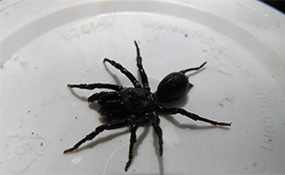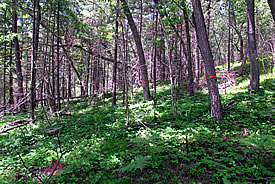The search for an elusive species

Black purse-web spider (Photo by Rob Craig, Ministry of Natural Resources and Forestry)
The black purse-web spider is not well known in Ontario. The species has been found occasionally across Southern Ontario, from Windsor to Belleville, including a recent find in Rouge Park in 2012. Interestingly, it belongs to the group of arachnids that includes tarantulas. But no need to panic; at the size of a penny, this black spider is non-venomous.
In Ontario, the species is relatively unknown as it tends to be secretive and hide in its intricately constructed purse web.
Located north of Cobourg, the Rice Lake Plains features oak savannah, prairies and sand barrens are present within this area — habitat that the black purse-web spider is known to prefer (in fact, the species had been found in the Rice Lake Plains, at the Alderville Black Oak Savanna in 2010 and 2011).
This summer, I joined a team of staff from the Ontario Ministry of Natural Resources and Forestry (MNRF), Ontario Natural Heritage Information Centre and Nature Conservancy of Canada (NCC) in search of the elusive species on several NCC properties in the Rice Lake Plains. After consulting with MNRF staff, the team headed to two locations in the hopes of finding the secretive spider. The first location, Burnley Carmel, is an NCC property managed by Ontario Parks as part of Peters Woods Provincial Nature reserve.
Once we identified ideal habitat for the species, we began to install traps at the base of trees. A container was placed in a small hole that left the container flush with the ground’s surface, and we added chemicals to the container to preserve the collected material. Then, we georeferenced the locations of over 30 traps.

Hazel Bird Nature Reserve, ON (Photo by NCC)
The next property we visited was NCC’s Hazel Bird Nature Reserve, a property secured in 2011 and named after a well-known naturalist who helped protect bluebirds in Northumberland County. The tallgrass communities on this property have been managed over the last several years with prescribed burns. This management technique has improved the quality of the habitat, which helps the species at risk that depend on it.
Four days later, the team returned to both sites. Anticipation ran high as we quickly went to the first trap looking for the spider. As it turns out, other creatures had been there before us. A racoon or a bear had visited the site and emptied a large number of containers. The team continued to check and document the rest of the traps. Unfortunately, no black purse-web spiders were found but other insect species were collected for future identification. MNRF’s Robert Craig noted that the spider would be easy to spot, as it wouldn’t resemble most of the other species or spiders in the trap. The traps were reset and the team headed on to the next location.
Next, we returned to Hazel Bird Nature Reserve. The team split into two groups to check the traps. It wasn't long before someone announce that they'd found something. We all quickly huddled around the trap, cameras in hand to document the occasion.
There was one perfectly identifiable black purse-web spider. Further searches of the remaining traps didn’t find any more.
A second set of traps at Burnley Carmel also yielde a single location of the black purse-web spider when the team rechecked the traps the following week.
Based on recent targeted surveys in the last few years, the spider has now been found at 17 locations. With three of the Ontario populations, the black purse-web spider has a stronghold in the Rice Lake Plains on NCC and partner properties. Information from the surveys will be provided to the federal government to update the status level under the Species at Risk Act.
While tarantula encounters are not on everyone's bucket list, let’s hope the sightings for this unique and special spider continue to climb.


